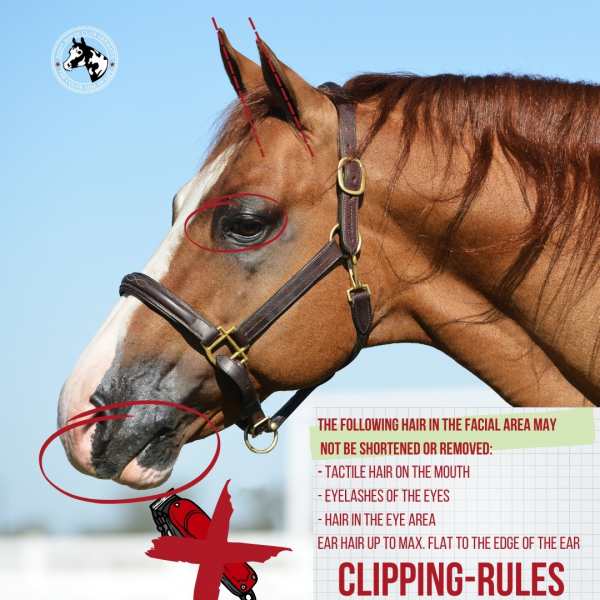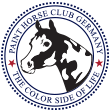Zum Start der Showsaison möchten wir eure Aufmerksamkeit auf die Clipping-Regeln des PHCG richten.
Auf allen APHA- und PHCG-Shows in Deutschland ist das Kürzen und Entfernen folgender Haare nicht erlaubt:
– Tasthaare am Maul
– Wimpern der Augen
– Haare im Augenbereich
Folgende Haare dürfen gekürzt werden:
– Hufbehang
– Haare unterhalb der Kinnlade
– Ohrenhaare jedoch bis max. plan zur Ohrenkante
Regelverstöße
Es werden alle Pferde auf die Einhaltung der Clipping-Regeln kontrolliert. Die Überprüfungen der Clipping-Regeln sind obligatorisch für alle Klassen, die von der APHA anerkannt sind sowie für die Klassen des PHCG. Der Kontrolleur hat jedes Pferd von PHCG-Mitgliedern zu überprüfen, dabei ist nicht relevant wer dieses Pferd vorstellt. Verstöße gegen die Regelungen, wie zum Beispiel das Clipping der Tasthaare, führen dazu, dass das betreffende Pferd aus den Wertungen des PHCG für das betreffende Jahr ausgeschlossen wird, dies kann auch rückwirkend geschehen. Das betreffende Pferd wird dem Amtsveterinär gemeldet, sowie vom Turnier ausgeschlossen. Eine Kostenerstattung findet nicht statt.
FAQ-Clipping:
In Deutschland ist speziell das Clippen der Tasthaare bei Pferden unter Tierschutzgesichtspunkten geregelt. Diese Tasthaare, auch Vibrissen genannt, befinden sich um die Nüstern und teilweise auch um die Augen der Pferde. Sie sind wichtig für die Wahrnehmung der Tiere, insbesondere im Nahbereich. Es gibt keine spezifische Längenangabe im Gesetz, ab wann Tasthaare als „nicht mehr geclippt“ gelten. Generell ist es jedoch so, dass die Haare als natürlich und ungeschnitten erscheinen sollten, um nicht gegen die Tierschutzrichtlinien zu verstoßen. Das bedeutet, dass die Haare vollständig nachwachsen und ihre natürliche Länge und Beschaffenheit erreichen müssen. Dies kann je nach Pferd und Wachstumsrate der Haare unterschiedlich lange dauern, üblicherweise mehrere Wochen bis Monate.
Wenn Sie planen, ein Pferd auf einer Show oder einem Turnier in Deutschland vorzustellen, und unsicher sind, ob die Länge der Tasthaare ausreichend ist, könnten Sie einen Tierarzt konsultieren. Der Tierarzt kann beurteilen, ob die Haare als natürlich gewachsen betrachtet werden können und somit keine Probleme bei einer möglichen Kontrolle entstehen.
At the start of the show season we would like to draw your attention to the clipping rules of the PHCG.
At all APHA and PHCG shows in Germany, the clipping and removal of the following hair is not permitted:
– Tactile hair on the mouth
– Eyelashes of the eyes
– Hair in the eye area
The following hair may be shortened:
– hoof hair
– Hair below the chin
– Ear hair, however, up to max. flat to the edge of the ear
Clipping rule inspections are mandatory for all APHA recognized classes and PHCG classes. The inspector must inspect every horse owned by a PHCG member, regardless of who is showing the horse. Violations of the regulations, such as clipping of the tactile hairs, will result in the horse in question being excluded from the PHCG special classes for the year in question, and this can also be done retroactively. The horse in question will be will be reported to the official veterinarian and excluded from further participation in the show and no refund of costs will be made.
FAQ-Clipping:
In Germany, the clipping of tactile hairs on horses is specifically regulated from an animal welfare perspective. These tactile hairs, also known as vibrissae, are located around the nostrils and sometimes also around the eyes of horses. They are important for the animal’s perception, especially at close range. There is no specific length specification in the law as to when vibrissae are considered “no longer clipped”. However, it is generally the case that the hair should appear natural and unclipped so as not to contravene animal welfare guidelines. This means that the hair must grow back completely and reach its natural length and texture. This can take varying amounts of time depending on the horse and the growth rate of the hair, usually several weeks to months.
If you are planning to show a horse at a show or competition in Germany and are unsure whether the length of the tactile hair is sufficient, you could consult a vet. The vet will be able to assess whether the hair can be considered to have grown naturally and therefore not cause any problems at a possible inspection.



